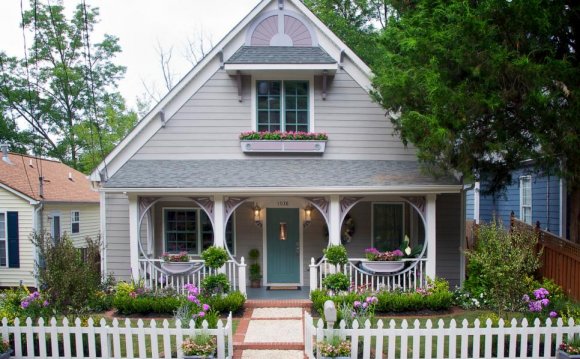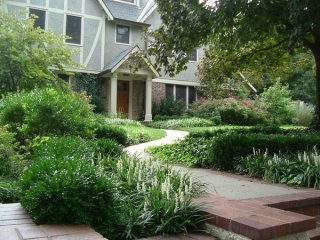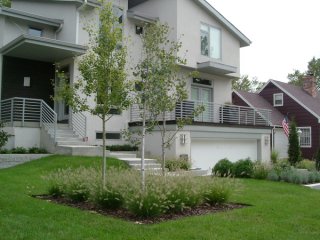

Overgrown shrubs crowd the front door of this home. When the shrubbery under the windows gets too big, the rooms inside feel dark and the views from the windows are compromised.
 "I just like to get away from the term foundation planting and make the entire front yard useable, " says Barbara Hilty, a landscape designer in Portland, Oregon. Old-fashioned plantings with evergreens across the front of the house and then lawn all the way to the curb do not really take full advantage of the possibilities, she says. When you re-imagine the space and bring the design out into the garden, away from the facade, a house becomes a nicer place to come home to. Reducing the size of the lawn and adding variety to the plantings out front is also better for the environment, Hilty says.
"I just like to get away from the term foundation planting and make the entire front yard useable, " says Barbara Hilty, a landscape designer in Portland, Oregon. Old-fashioned plantings with evergreens across the front of the house and then lawn all the way to the curb do not really take full advantage of the possibilities, she says. When you re-imagine the space and bring the design out into the garden, away from the facade, a house becomes a nicer place to come home to. Reducing the size of the lawn and adding variety to the plantings out front is also better for the environment, Hilty says.
 Foundation plantings traditionally were designed to cover up the stone or brick around the base of a house. A very simple old-fashioned planting might rely on just one species, such as yews or junipers, or perhaps azaleas, to help nestle a house into the landscape. Too often, these shrubs are planted too close to the house and then ignored until they become overgrown, obscuring the house and blocking views from inside.
Foundation plantings traditionally were designed to cover up the stone or brick around the base of a house. A very simple old-fashioned planting might rely on just one species, such as yews or junipers, or perhaps azaleas, to help nestle a house into the landscape. Too often, these shrubs are planted too close to the house and then ignored until they become overgrown, obscuring the house and blocking views from inside.
Jane Cantin, a landscape architect in Norfolk, Virginia, sees overgrown foundation plantings all the time. "It's those cute little Alberta spruces, " she says. "They look like little baby Christmas trees. But after a few years they eat up the sidewalk. You can't even get to the front door." In frustration, homeowners try to prune them, but their efforts frequently backfire. "The shrubs get so whacked and wonky that they don't come back, and you just have to take them out, " Cantin says.
Source: www.uexpress.com
Landscaping Tips
Though your home is your castle, there is no necessity to surround it with a moat. Here are 5 tips that will help you to make your landscaping feel more warm, welcoming and cozy.
1. Put some flowers nearby your entrance. Flowers make any area look more welcoming and attractive, so greeting your guests with Petunia, Snapdragon, Lily-of-the-Nile or some other garden flowers is always a great thing to do. What is more, to add some space between your house and the entrance, you can consider adding a little white fence. It will create an illusion that your front yard is bigger than it actually is. What is more, adding fence will create a great space for planting flowers to add some color and coziness.
2. Add rambling vines to make your yard look absolutely lovely. You can not deny that rambling vines always create romantic and even magical atmosphere. So why not to use this tip while decorating your yard?
3. To hide the unattractive driveway, consider adding some color, texture, and height. You can easily do it by adding various sorts of flowers. To start, create an island of green lawn right in the hub of a drive. Then add a couple of low boxwood hedges with flowers toward the back of your island.
4. If you want your yard to blossom and flourish bust still do not have enough time to maintain it, consider planting low-fuss lilies. Such flowers look absolutely gorgeous and come in the variety of rainbow hues, so you can pick the one you love most. What is more, low-fuss lilies do not care about the sort of soil, they love the sun and welcome hot, they do not afraid of drought. In other words, Crinums is an ideal flower for all those who are looking for low-maintenance solutions.
5. The last tip also touches the low-maintenance aspect. To make your life easier, group plantings into beds and islands. This will help you to avoid mowing and trimming around each individual plant, save a lot of time and even money.


 "I just like to get away from the term foundation planting and make the entire front yard useable, " says Barbara Hilty, a landscape designer in Portland, Oregon. Old-fashioned plantings with evergreens across the front of the house and then lawn all the way to the curb do not really take full advantage of the possibilities, she says. When you re-imagine the space and bring the design out into the garden, away from the facade, a house becomes a nicer place to come home to. Reducing the size of the lawn and adding variety to the plantings out front is also better for the environment, Hilty says.
"I just like to get away from the term foundation planting and make the entire front yard useable, " says Barbara Hilty, a landscape designer in Portland, Oregon. Old-fashioned plantings with evergreens across the front of the house and then lawn all the way to the curb do not really take full advantage of the possibilities, she says. When you re-imagine the space and bring the design out into the garden, away from the facade, a house becomes a nicer place to come home to. Reducing the size of the lawn and adding variety to the plantings out front is also better for the environment, Hilty says. Foundation plantings traditionally were designed to cover up the stone or brick around the base of a house. A very simple old-fashioned planting might rely on just one species, such as yews or junipers, or perhaps azaleas, to help nestle a house into the landscape. Too often, these shrubs are planted too close to the house and then ignored until they become overgrown, obscuring the house and blocking views from inside.
Foundation plantings traditionally were designed to cover up the stone or brick around the base of a house. A very simple old-fashioned planting might rely on just one species, such as yews or junipers, or perhaps azaleas, to help nestle a house into the landscape. Too often, these shrubs are planted too close to the house and then ignored until they become overgrown, obscuring the house and blocking views from inside.














